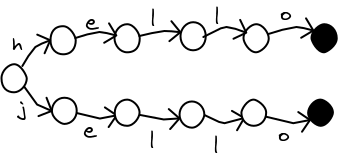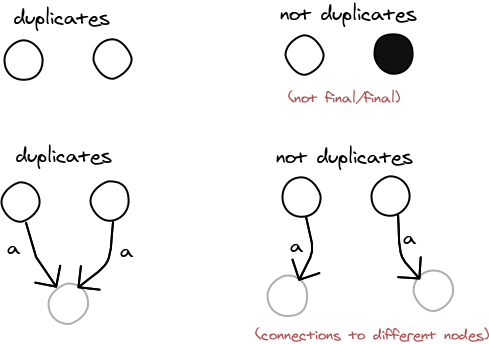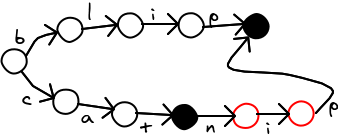It's a dirty job... (comic)


Last time, I wrote about how to speed up spell checking using a trie (also known as a prefix tree). However, for large dictionaries, a trie can waste a lot of memory. If you're trying to squeeze an application into a mobile device, every kilobyte counts. Consider this trie, with two words in it.

It can be shortened in a way so that any program accessing it would not even notice.

As early as 1988, ScrabbleTM programs were using structures like the above to shrink the their dictionaries. Over the years, the structure has been called many things. Some web pages call it a DAWG (Direct Acyclic Word Graph). But computer scientists have adopted the name "Minimal Acyclic Finite State Automaton", because some papers were already using the name DAWG for something else.
The most obvious way to build a MA-FSA, as suggested in many other web pages, is to first build the trie, and look for duplicate branches. I tried this on a list of 7 million words that I had. I wrote the algorithm in C++, but no matter how hard I tried, I kept running out of memory. A trie (or prefix tree) uses a lot of memory compared to a DAWG. It would be much better if one could create the DAWG right away, without first creating a trie. Jan Duciuk describes such a method in his paper. The central idea is to check for duplicates after you insert each word, so that the structure never gets huge.

The paper that I am paraphrasing, by Jan Daciuk and others, also describes a way to insert words out of order. But it is more complicated. In most cases, you can arrange to add your words in alphabetical order.
Two nodes are considered the same if they are both the final part of a word, or they are both not the final part of a word. They also need to have exactly the same edges pointing to exactly the same other nodes.

We start eliminating duplicates starting from the bottom of the branch, so each elimination can reveal more duplicates. Eventually, the branch of the trie zips together with a prior branch.
Step 1:

Several steps later:

If you have a large word list, you could run it through gzip and get much better compression. The reason for storing a dictionary this way is to save space and remain easily searchable, without needing to decompress it first. Tries and MA-FSAs can support fuzzy search and prefix queries, so you can do spell checking and auto-completion. They can easily scale up to billions of entries. They have even been used to store large portions of the human genome. If you don't care about memory or speed, just store your words in an SQL database, or spin up 100 machines "in the cloud". I don't mind. More power to you!
MA-FSAs can be stored in as little as 4 bytes per edge-connector, as described by this web page.
#!/usr/bin/python
# By Steve Hanov, 2011. Released to the public domain.
import sys
import time
DICTIONARY = "/usr/share/dict/words"
QUERY = sys.argv[1:]
# This class represents a node in the directed acyclic word graph (DAWG). It
# has a list of edges to other nodes. It has functions for testing whether it
# is equivalent to another node. Nodes are equivalent if they have identical
# edges, and each identical edge leads to identical states. The __hash__ and
# __eq__ functions allow it to be used as a key in a python dictionary.
class DawgNode:
NextId = 0
def __init__(self):
self.id = DawgNode.NextId
DawgNode.NextId += 1
self.final = False
self.edges = {}
def __str__(self):
arr = []
if self.final:
arr.append("1")
else:
arr.append("0")
for (label, node) in self.edges.iteritems():
arr.append( label )
arr.append( str( node.id ) )
return "_".join(arr)
def __hash__(self):
return self.__str__().__hash__()
def __eq__(self, other):
return self.__str__() == other.__str__()
class Dawg:
def __init__(self):
self.previousWord = ""
self.root = DawgNode()
# Here is a list of nodes that have not been checked for duplication.
self.uncheckedNodes = []
# Here is a list of unique nodes that have been checked for
# duplication.
self.minimizedNodes = {}
def insert( self, word ):
if word < self.previousWord:
raise Exception("Error: Words must be inserted in alphabetical " +
"order.")
# find common prefix between word and previous word
commonPrefix = 0
for i in range( min( len( word ), len( self.previousWord ) ) ):
if word[i] != self.previousWord[i]: break
commonPrefix += 1
# Check the uncheckedNodes for redundant nodes, proceeding from last
# one down to the common prefix size. Then truncate the list at that
# point.
self._minimize( commonPrefix )
# add the suffix, starting from the correct node mid-way through the
# graph
if len(self.uncheckedNodes) == 0:
node = self.root
else:
node = self.uncheckedNodes[-1][2]
for letter in word[commonPrefix:]:
nextNode = DawgNode()
node.edges[letter] = nextNode
self.uncheckedNodes.append( (node, letter, nextNode) )
node = nextNode
node.final = True
self.previousWord = word
def finish( self ):
# minimize all uncheckedNodes
self._minimize( 0 );
def _minimize( self, downTo ):
# proceed from the leaf up to a certain point
for i in range( len(self.uncheckedNodes) - 1, downTo - 1, -1 ):
(parent, letter, child) = self.uncheckedNodes[i];
if child in self.minimizedNodes:
# replace the child with the previously encountered one
parent.edges[letter] = self.minimizedNodes[child]
else:
# add the state to the minimized nodes.
self.minimizedNodes[child] = child;
self.uncheckedNodes.pop()
def lookup( self, word ):
node = self.root
for letter in word:
if letter not in node.edges: return False
node = node.edges[letter]
return node.final
def nodeCount( self ):
return len(self.minimizedNodes)
def edgeCount( self ):
count = 0
for node in self.minimizedNodes:
count += len(node.edges)
return count
dawg = Dawg()
WordCount = 0
words = open(DICTIONARY, "rt").read().split()
words.sort()
start = time.time()
for word in words:
WordCount += 1
dawg.insert(word)
if ( WordCount % 100 ) == 0: print "%dr" % WordCount,
dawg.finish()
print "Dawg creation took %g s" % (time.time()-start)
EdgeCount = dawg.edgeCount()
print "Read %d words into %d nodes and %d edges" % ( WordCount,
dawg.nodeCount(), EdgeCount )
print "This could be stored in as little as %d bytes" % (EdgeCount * 4)
for word in QUERY:
if not dawg.lookup( word ):
print "%s not in dictionary." % word
else:
print "%s is in the dictionary." % word
Updated code on github: using a DAWG as a map
Using this code, a list of 7 million words, taking up 63 MB, was translated into 6 million edges. Although it took more than a gigabyte of memory in Python, such a list could be stored in as little as 24 MB. Of course, gzip could do better, but the result would not be quickly searchable.A MA-FSA is great for testing whether words are in a dictionary. But in the form I gave, it's not possible to retrieve values associated with the words. It is possible to include associated values in the automaton. Such structures are called "Minimal Acyclic Finite State Transducers". In fact, the algorithm I above can be easily modified to include a value. However, it causes the number of nodes to blow up, and you are much better off using a minimal perfect hash function in addition to your MA-FSA to store your data. I discuss this in part 3.
Can you explain this for me? I don't understand this.
I'd be really interested in some way to get every entry in the DAWG that's less than some edit-distance (Levenshtein) D away from a given string.
I am using this code unchanged in several projects and it is working.
I did not use a trie, but rather a more compact data structure where I kept lists of words broken out by length (3 letters to 8 letters in my case) and then by the first two letters (e.g. "ta" vs. "to"). For each such group, I just stored the remaining letters squished together in an array. So for 3 letter words starting with "to" I might store "npt" representing "ton", "top", "tot"; for 4 letter words starting with "to" I might store "admert" representing "toad", "tome", "tort".
To look up a word, I just use its length and first to letters, then start skipping through the array (binary search) of legal suffixes to see if it's present or not.
"For example, "cat" followed by <b>"catsnip"</b> does not result in a branch"
Thank for this document :D
You can check for duplicates with a hash table of subtrees. I implemented this approach in C few years ago:
www.strchr.com/ternary_dags
 Now it's a commercial product, but Zwibbler was once a fun side-project, and here's some details on its implementation.
Now it's a commercial product, but Zwibbler was once a fun side-project, and here's some details on its implementation.
 Here's what you can do to get the most out of your business in Canada if all of your revenue comes in US dollars.
Here's what you can do to get the most out of your business in Canada if all of your revenue comes in US dollars.
 Let's say you have millions of pictures of faces tagged with names. Given a new photo, how do you find the name of person that the photo most resembles?
Let's say you have millions of pictures of faces tagged with names. Given a new photo, how do you find the name of person that the photo most resembles?
In the cases I mentioned, each record has hundreds or thousands of elements: the pixels in a photo, or patterns in a sound snippet, or web usage data. These records can be regarded as points in high dimensional space. When you look at a points in space, they tend to form clusters, and you can infer a lot by looking at ones nearby.